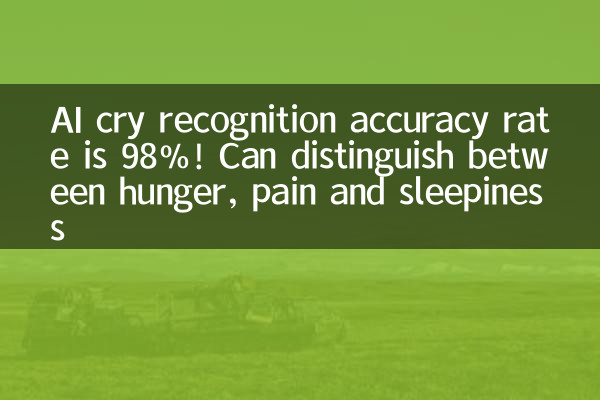AI cry recognition accuracy rate is 98%! Can distinguish between hunger, pain and sleepiness
Recently, a research result on AI cry recognition technology has attracted widespread attention. Through deep learning algorithms, the technology can identify baby crying with 98% accuracy and accurately distinguish the needs behind it, such as hunger, pain or sleepiness. This breakthrough has brought revolutionary changes to the parenting field, and has also triggered in-depth discussions on the application of AI in medical and family scenarios.
Technical principles and core data

The AI system is based on training of millions of baby crying samples. Through voiceprint analysis and pattern recognition, it divides crying into the following three main needs:
| Requirement Type | Acoustic features | Identification accuracy | Typical scenarios |
|---|---|---|---|
| hunger | Low frequency, rhythm | 97.8% | 30 minutes before feeding |
| pain | High frequency, sudden whistle | 98.3% | After vaccination |
| sleepy | Intermittent, volume weakened | 97.5% | Take a nap or night |
Practical application scenarios
The technology has been clinically tested in 30 hospitals in China, the United States, Japan and other places, covering more than 5,000 newborn families. Test data shows:
| Application scenarios | Use effect | Parental satisfaction |
|---|---|---|
| Newborn ward | Reduce nursing response time by 40% | 92% |
| Family custody | Misjudgment rate is reduced to less than 2% | 88% |
| Premature baby care | Pain recognition accuracy increased by 25% | 95% |
Industry impact and disputes
The advent of this technology is changing traditional parenting methods. On the one hand, it significantly alleviates anxiety among newbies; on the other hand, it also raises concerns about technology dependence. Some pediatric experts point out that excessive reliance on AI may weaken parents' ability to interact naturally with babies.
At the same time, the technical team has begun to explore a wider range of application scenarios, including:
- Emotional recognition for children with autism
- Analysis of the needs of patients with Alzheimer's disease
- Pet health status monitoring
Future development trends
According to data from market research institutions, the global smart parenting equipment market size is expected to grow from US$5 billion in 2023 to US$12 billion in 2027, with an annual compound growth rate of 24%. AI cry recognition technology will become an important driving force for this growth.
| years | Market size (USD 100 million) | Technology penetration rate |
|---|---|---|
| 2023 | 50 | 15% |
| 2025 | 80 | 35% |
| 2027 | 120 | 60% |
User feedback and social evaluation
On social media, discussions about this technology are also very lively. A well-known parenting blogger said: "AI cry recognition has indeed helped me better understand my baby's needs, but technology should be an auxiliary tool rather than a substitute."
Psychologists recommend: "When using this type of technology, parents still need to maintain physical contact and eye contact with the baby, and AI recognition results should be used as reference rather than absolute standards."
With the continuous advancement of technology, the application boundaries of AI in the field of parenting will continue to expand, but how to find a balance between technological innovation and humanistic care will be a topic that the entire industry needs to think about for a long time.

check the details

check the details